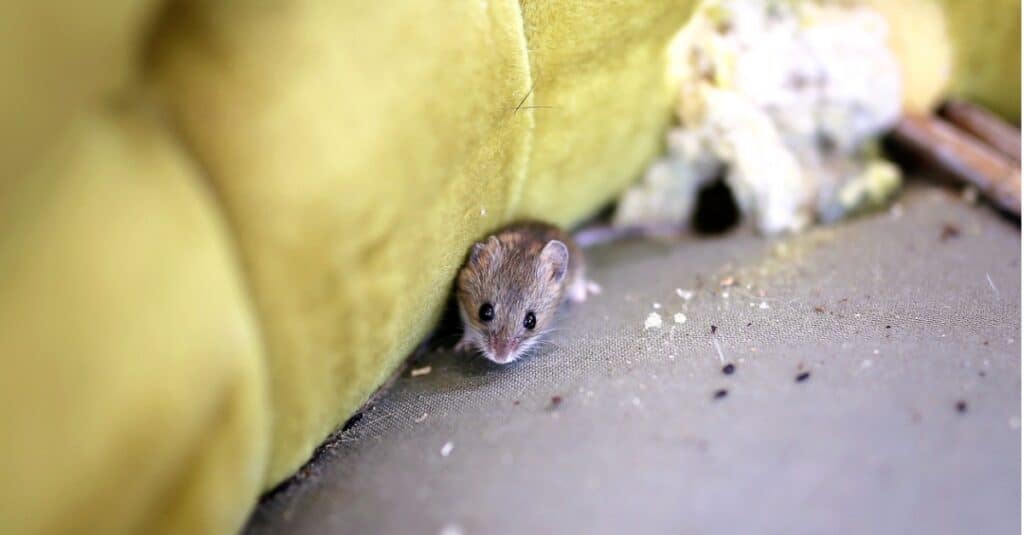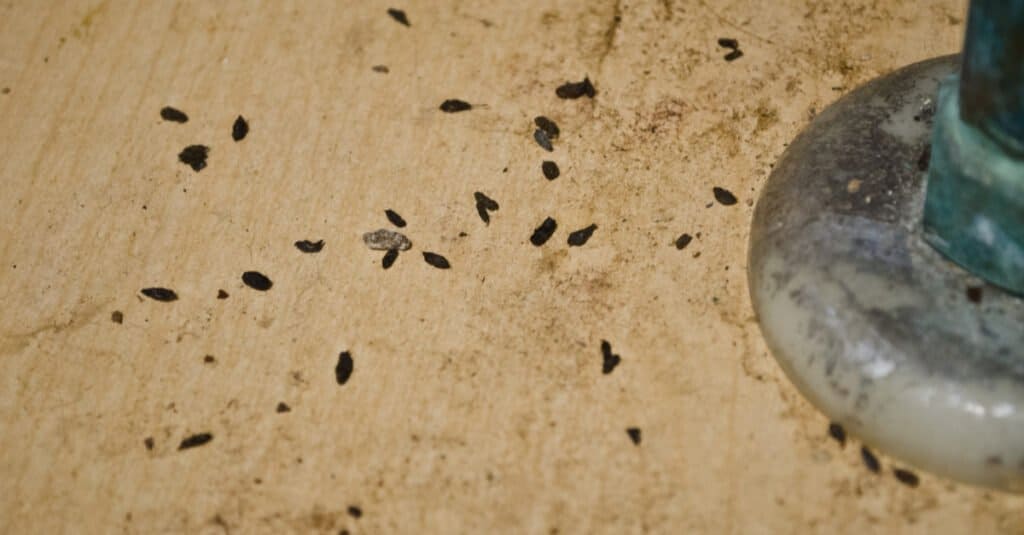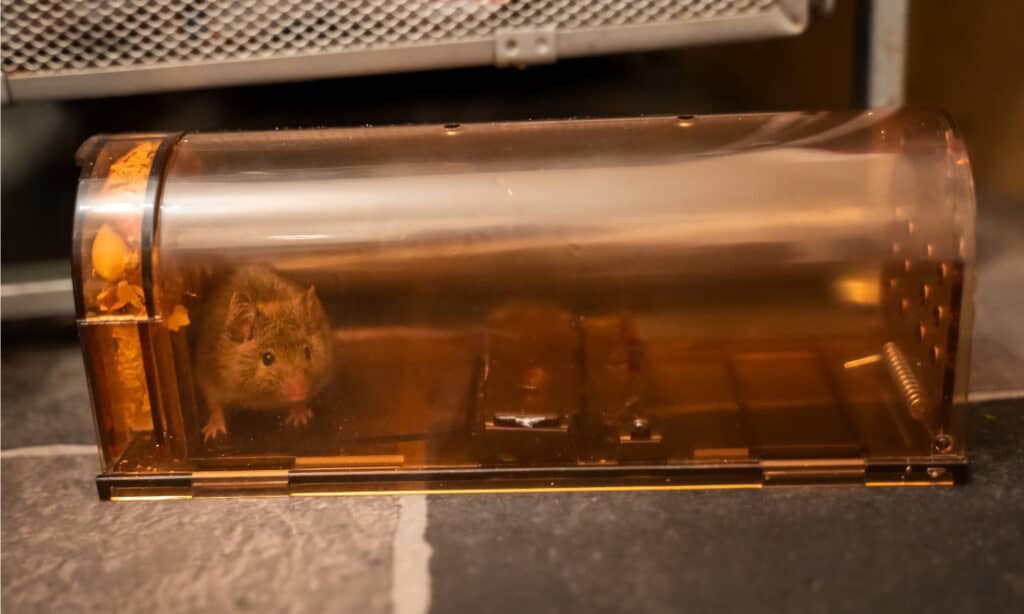When you see mice scurrying along the ground, you probably wonder how they get from one place to another. For the most part, mice are known for being very effective climbers. However, that form of travel does not explain how they get to all the different parts of homes and outbuildings. Instead, they often jump to reach new places. That’s right; mice can jump. So, how high can mice jump?
We’ll take a look at what science says about the acrobatic capabilities of mice!
How Well Do Mice Climb?

Mice are incredible climbers.
©Rudmer Zwerver/Shutterstock.com
Mice are very adept climbers that use their feet and claws to scale walls and stairs in homes. Although it may seem hard to believe, mice are very effective at climbing vertical surfaces.
The secret to their success lies in their lightweight bodies and ability to turn the slightest imperfections into a place that they can use to hold onto with their claws
Mice can climb up many surfaces, including:
- Drywall
- Metal siding
- Stucco
- Brick
- Concrete
These porous surfaces allow mice to climb very well. Yet, there are also some surfaces that mice cannot climb, such as smooth plastic, metal, and glazed wood. These do not offer mice an area to grip. However, mice do not always need a place to grip to travel. They can jump very well, and they can swim rather well, too.
How High Can Mice Jump?

Mice can jump over a foot high.
©iStock.com/ChristinLola
Average mice can jump anywhere up to about 13 inches without a running start and even higher when they’re already moving. The average 5-gallon bucket is about 12 inches tall, meaning it is not tall enough to contain a mouse. It will leap out without a lid on it. Of course, every mouse is different, and some of the worst jumpers have been recorded jumping about 10 inches high.
That is a powerful jump coming from such a small creature. However, mice have been seen jumping out of containers up to 24 inches tall. We have to ask whether mice are doing that jump in a single bound or not. Remember, mice are good climbers and can find caveats to use as a foothold. In those cases, mice will do a double jump to get exceptionally high.
Aside from having a very powerful vertical jump, mice can also leap for over 2 ft horizontally if they have a running start. That means that a mouse can get from your kitchen table to your countertops and into your cabinets with ease.
Of course, exceptions exist in all things in the animal kingdom, and the jumping distance of mice is one of them. The measurements we provided for the height and length of a mouse’s jump are just for your average house mouse.
While they might not be true mice, jumping mice have specialized feet and legs that allow them to jump for far longer distances. In fact, they can leap anywhere between 9 ft and 13 ft horizontally, especially when they’re in danger.
While all mice can jump well, jumping mice are built to jump even better!
Why Is It Important to Know How High Mice Jump?

Knowing how high mice jump can help you find more evidence of their presence.
©Pegasene/Shutterstock.com
Now that we know how high mice jump and how far they can leap, we must apply this knowledge. You can use this information to figure out what places in your home are in danger of having mice enter them.
For example, imagine that you get a pot from your bottom cabinet to cook dinner, and you discover mouse droppings. Obviously, you need to clean and disinfect the dishes in those areas. But do you need to stop there? Could the mice have gotten somewhere else?
Even though you found the droppings on the ground level of your kitchen, you don’t want to stop looking for signs of mice there. Look in any place that a mouse could climb or jump to from that cabinet and check there as well.
You’ll be surprised how often mice can climb a wall, run along a curtain rod, or jump from counter to counter in search of food.
Knowing how well mice can travel in your home allows you to properly expand your search area for them. That way, you can sanitize everything that they touched to prevent diseases spread by mice from passing to you. Also, you can begin to lay down traps and repel mice using natural or synthetic solutions.
You must learn to look farther than the initial place where you found evidence of mice in your home.
How Do You Get Mice Out of Your House?

Removing mice from your home is a process.
©lortek/Shutterstock.com
As soon as you have evidence that mice are in your home, you need a plan to get them out. If you’re not up for it, call a professional exterminator. However, if you aren’t afraid to put on a pair of gloves and a mask to get the job done, then follow these steps.
- Identify ways that mice are getting into your home and shut them out by sealing up holes with something too hard for mice to chew through, like metal or cement.
- Repel mice with strong scents like cayenne pepper, peppermint, and dryer sheets.
- Consider adopting a pet, like a cat, as a companion and pest control agent.
- Properly bait mouse traps and set them in places where evidence of mice has been seen inside your home.
- Place mouse traps around the exterior of your home.
- Consider using mouse poisons, but only if you do not have pets or children.
Use these methods to get mice out of your house. Remember that mice can get to places that you wouldn’t imagine. When you are setting traps, make sure to set them properly and in places in and around where you have seen evidence of mice.
We’ve answered, how high can mice jump? Now you know just how cunning these creatures can be. We like to imagine that they are limited by their ability to scale surfaces, but that’s not true. They are more intelligent than we give them credit for, and they are also far more athletic than most people imagine.
The photo featured at the top of this post is © iStock.com/LaperladiLabuan
Thank you for reading! Have some feedback for us? Contact the AZ Animals editorial team.






